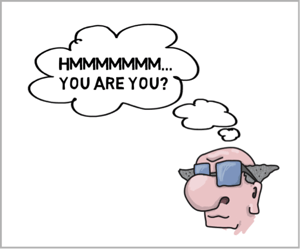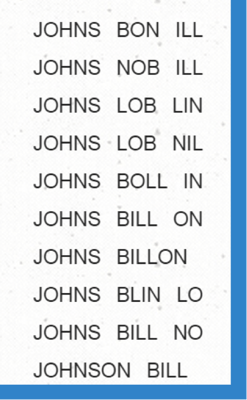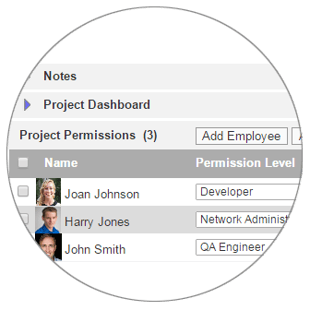Nice To Meet You

He’s the tenth person to approach you since you walked into the event.
He offers his name with a smile and a firm handshake.You smile back. “Nice to meet you.”
And, just like that, you shake hands and completely forget whatever he said his name was.

This is a situation I am all too familiar with. After meeting someone new, it's always only a matter of minutes before I forget their name. Faces, on the other hand, I rarely forget. Beyond recognizing someone, I can often remember other details about the person, such as their job or whatever fact it was they told me when we were first introduced. But ask me their name and I will be forced to admit defeat.
Research Says Faces Easier To Remember Than Names
So why are faces so much easier to remember than names?
According to E. Clea Warburton, a cognitive neuroscientist at the University of Bristol, faces are easier to remember because a larger portion of our brain is dedicated to processing and storing visual information than any of our other senses. Warburton posits that this brain structure may have its origins in our evolution as socially interdependent primates. Although we now have language and commonly name objects and individuals, our ancestors relied primarily on sight to relate to the world around them.
The face is also a more engaging stimulus. An assistant professor of psychology at Gettysburg College studying facial recognition, Richard Russell points out that the face conveys many things at once: gender, age, ethnicity, mood, and attractiveness, to name a few. Each of these are simply one feature that together make up a person’s greater identity.
 Names are easily scrambled up
Names are easily scrambled up
In contrast, a name is simply a collection of letters or characters that are not unique to a single individual. For example, I have three aunts named Mary. If one of them leaves me a voice message and simply identifies themselves as “Auntie Mary,” that really does not help me figure out which aunt is actually calling. In person, however, all three aunts have very different facial features and physical characteristics like height, weight, hair color, eye color that make them immediately distinguishable.
Now, what does this have to do with employee identification in the field, or even in the office?
If remembering the names of ten people at a networking event or distinguishing between my three Aunt Marys is difficult, all hell breaks loose in an enterprise with hundreds or thousands of employees. With employees working in different departments, locations, crews, job sites, and on different projects, it’s amazing that employee identification problems are not more common.
Employee Identification Is Big Problem
Unfortunately, they do come up. In some situations, these problems come up a lot.
Let’s get back to names. In large organizations or on job sites with lots of workers, you have to deal with many employees, some of whom may have similar or identical last names. In cases like these, last names are rendered unhelpful for identifying employees that you do not know very well already. And I’m not talking about the unique, sometimes strange names, but about all of the Smiths, Lees, and Garcias in the world.
Employee Authentication Tools Not Perfect Solutions
Some systems that identify workers, like human resource or time and attendance systems, attempt to solve this problem with biometric employee identification systems. These can include fingerprint or handprint scanning and recognition to authenticate the person before recording their start, finish or break times. However, this can be expensive and time consuming, depending on the size of your company. Additionally, biometrics are always not practical in the field. The condition of workers’ hands in heavy industries can make getting a good finger print, a print that’s not buffed smooth, a difficult task. Enrolling these new workers in a system can be cumbersome if not impossible. At some job sites it’s difficult to secure biometric readers from being stolen.
ID Cards, ProximityCards, and Swipe Cards Far From Perfect
Other methods to identify workers use some other employee credential, such as the employee’s company identification number. ID cards are often issued with the employee’s name, company ID, perhaps a home department or location, and a photo can appear on the card. ID cards can also be encoded with data so they can be used as proximity cards to clock in or out with a time clock terminal, or to gain access to a work area or building through an access control system.
Same-Day Hires and Other Problems
In the field, where same-day hires are routine, ID cards are not always easy to issue quickly. Workers can come and go between sites or companies. ID cards are easily lost. For clocking in and out, co-workers can do so-called “buddy punching,” swiping their buddy’s card so their absent friend appears to be on the job when they’re really playing golf.
In short, there is a constant need to know who is standing in front of you, who you are talking to on the phone, which worker was working for you yesterday, and who might be working for you tomorrow. In the field, if proximity cards are without photos it’s more than awkward to continually swipe a worker’s ID card to verify his identity, like you’re doing a price check at Costco.
A Simpler Basic Solution

At Pacific Timesheet, while we provide biometric, ID card, proximity card and other standard tools to authenticate an employee’s identity in a time and attendance situation, we also offer an even simpler solution.
We offer comprehensive employee identification tools along with identity management and single sign-on tools. Our employee profile system gives you easy access to an employee’s public profile whether you’re in the office or in the field. This is critical when you need to make a resource decision or verify that the employee in front of you matches the photo in his electronic profile, especially in the event of a language barrier.
The Cost of Employee Mis-identification
It’s a problem Pacific Timesheet has heard about from customers for years.
Failure to identify an employee correctly in the field can lead to improper assignments, paying people the wrong wages, or worse.
The solution is a utility that allows you to easily upload employee photos directly into our systems, or synchronize them directly from your human resources data stores or web services.
The applications are basic but critically helpful for managers.
For example, a foreman, superintendent or general foreman can view a public mini-profile right from the crew timesheet. The mini-profile has key identifiers like the employee’s photo and key properties needed to assign and manage him properly.
Project Managers and resource managers on a conference call can view mini-profiles with an employee’s resource properties, skill sets or credentials when deciding how to form project teams. And, like with my Auntie Marys, they can finally put a face to the voice without having to become friends on Facebook or search for them on Google or LinkedIn.
What do you think?
In the comment section below, let us know your biggest employee identification challenges and the approaches you’ve used. What have been your most effective solutions?
Source: ScienceFriday.com; Image Source: Flickr.com



